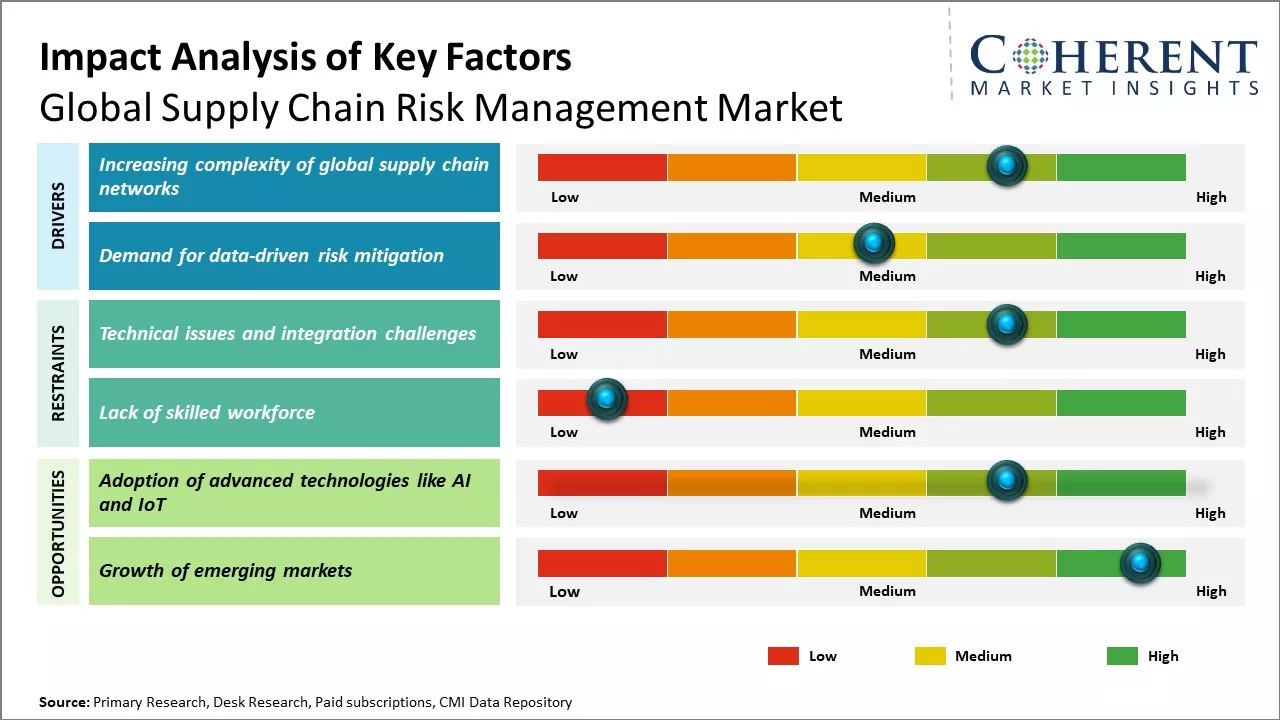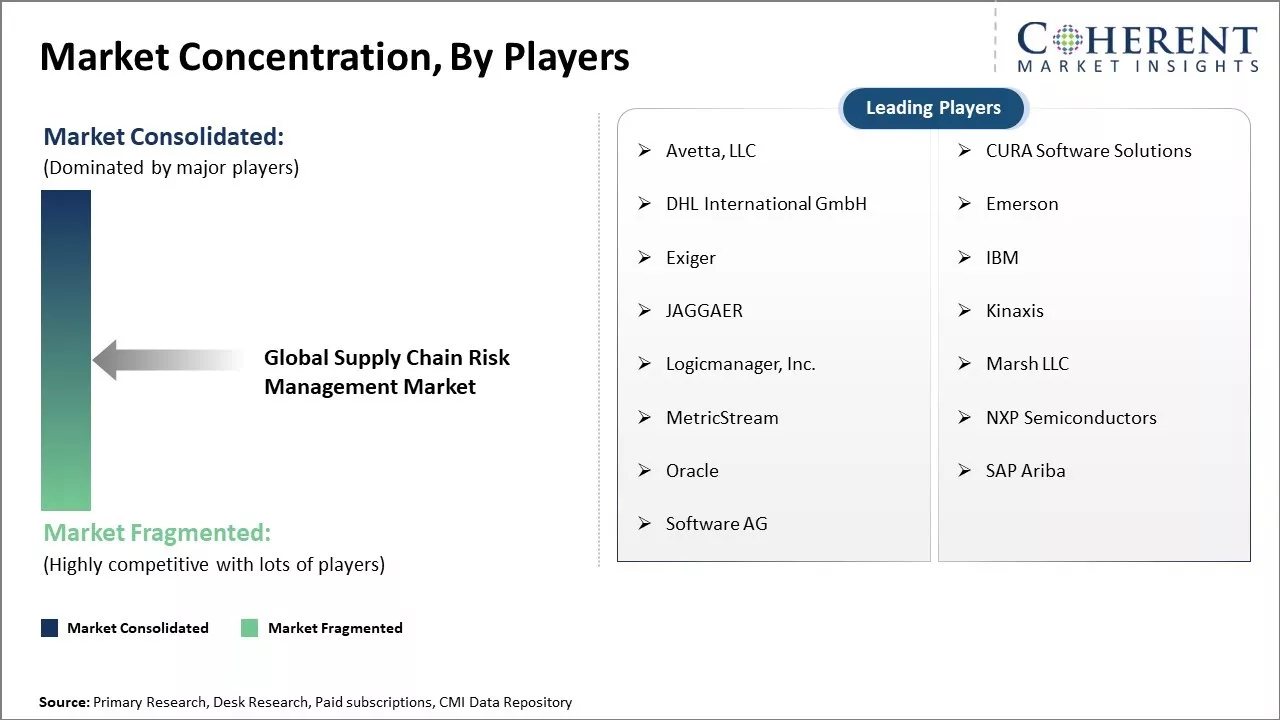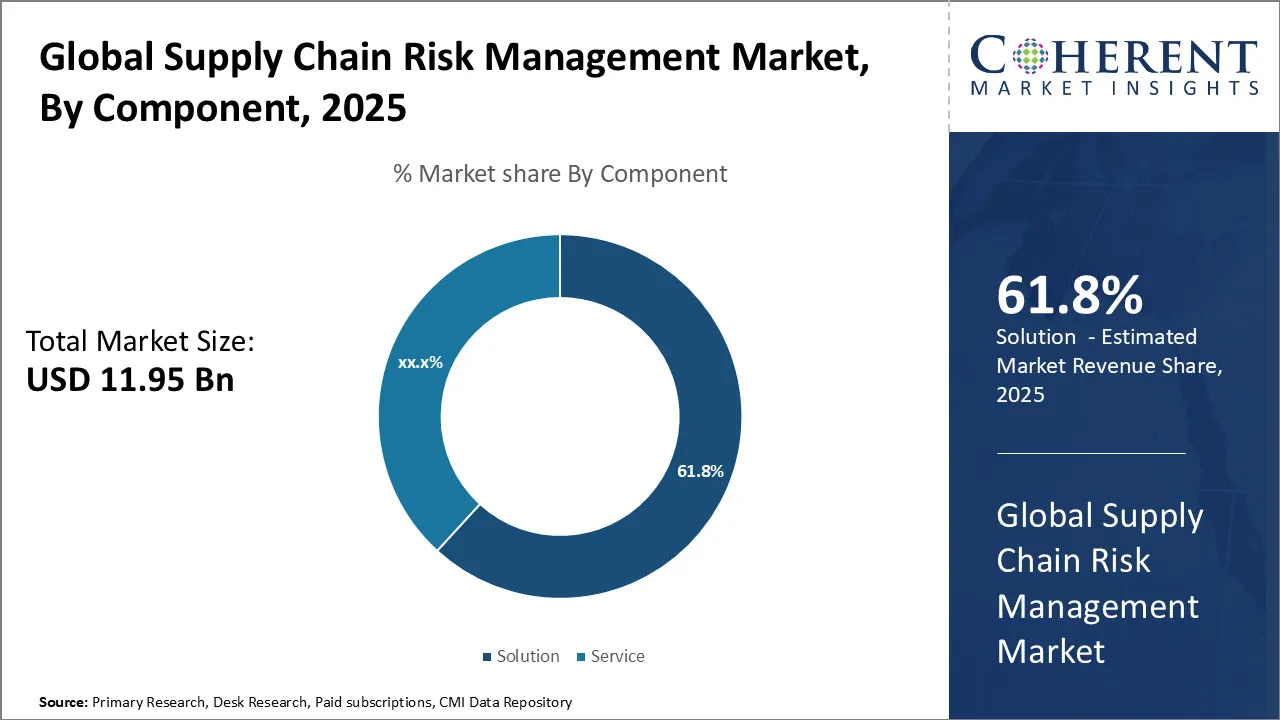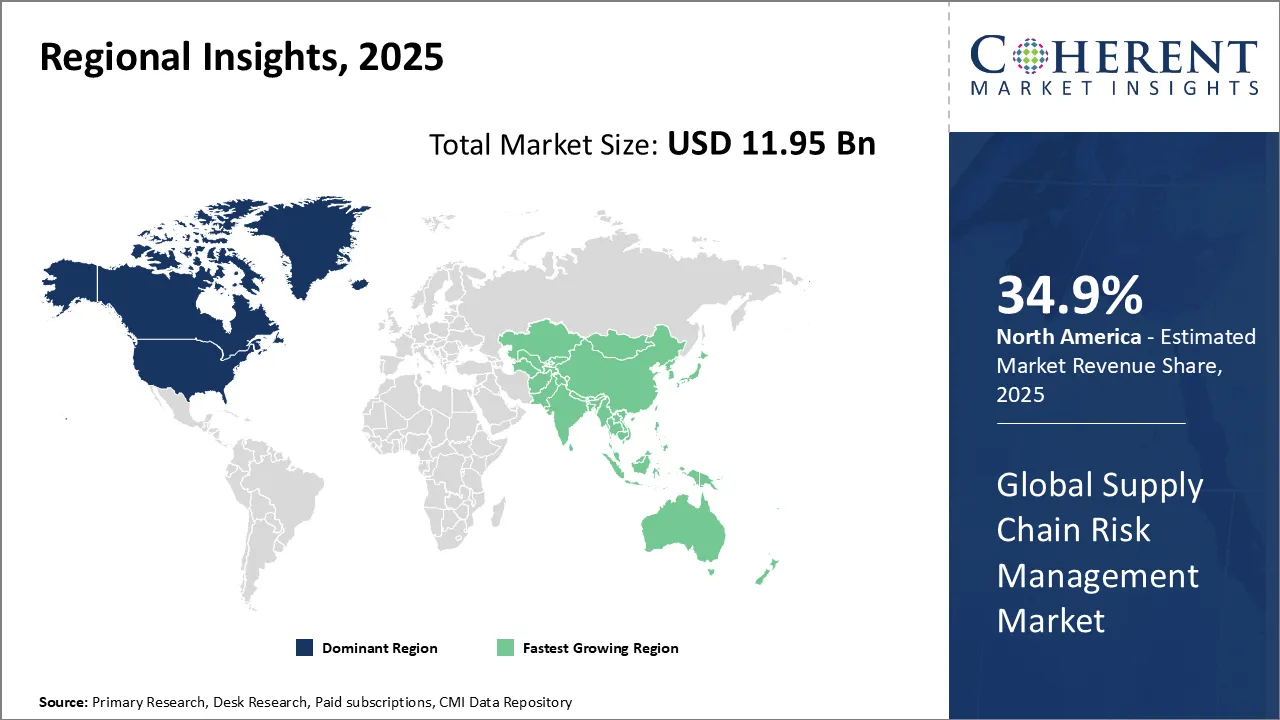Global supply chain risk management market is estimated to be valued at US$ 11.95 Bn in 2025 and is expected to reach US$ 23.92 Bn by 2032, exhibiting a compound annual growth rate (CAGR) of 10.4% from 2025 to 2032.

Discover market dynamics shaping the industry: Download Free Sample
The market is witnessing growth due to increasing globalization of supply chain operations and growing complexities across supply chain networks. Various factors such as rising geopolitical tensions, regulations, environmental vulnerabilities and information technology risks are forcing companies to focus more on risk preparedness and resilience. Adoption of technologies like AI, IoT and blockchain is helping organizations to gain end-to-end visibility and agility to combat disruptions. Furthermore, rising talent crunch push vendors to offer more online training and resources to create a future-ready workforce for managing supply chain complexities. The coronavirus pandemic has also underscored the need for robust risk management strategies and governance.
Increasing complexity of global supply chain networks
As businesses operate across borders and regions to gain strategic advantage, their supply chain networks have become highly complex with multiple tiers of suppliers, manufacturing and distribution centers spread globally. Managing such extensive networks involve coordination of large number of partners and flow of materials, information and finances across the world. With growing networks, even small disruptions due to factors like supplier non-performance, natural disasters, pandemic outbreak, political instability or trade disputes can significantly impact the business operations. This increases the risks which are difficult to foresee and mitigate with traditional risk management approaches. To sustain in this dynamic environment, companies require advanced risk management strategies that provide end-to-end visibility across networks, monitor risks in real-time and support contingency planning. This boosts greater focus on supply chain risk management solutions that help maintain business continuity and resilience against disruptions through robust risk assessment, scenario modeling and coordinated response capabilities.

Get actionable strategies to beat competition: Download Free Sample
Demand for data-driven risk mitigation
Data has become the lifeline for businesses to gain insights and make informed decisions. Due to rising proliferation of IoT technologies, large volumes of transactional and sensor data is being generated within supply chain operations on a daily basis. However, most of this data remains untapped and underutilized for risk management. Traditional methods rely heavily on manual assessment and are reactionary in nature. To stay ahead of risks, companies are looking to leverage big data analytics and AI/ML techniques to extract meaningful patterns and signals from disparate data sources. This helps identify emerging risks proactively, assess the impact of risks more accurately considering historical trends and current operations status. Data-driven approaches also support scenario modeling and "what-if" analysis to evaluate mitigation plans. Vendors offering cloud-based risk management platforms integrated with predictive analytics and data visualization capabilities are gaining popularity. These enable informed risk-based decision making across strategic, tactical and operational levels of supply chain management.
Key Takeaways from Analyst:
Increasingly complex global supply chain networks have exposed businesses to greater risks such as disruptions, delays and monetary losses. Mitigating these risks has become a top priority for organizations.
Rising geo-political tensions, natural calamities and trade wars, which have highlighted the need for proactive risk management strategies, can drive the market growth. Automation and data analytics capabilities being offered by risk management solutions prompt enterprises to adopt these solutions. However, high initial costs and reluctance to share critical supplier data may impede the adoption of supply chain risk management systems.
North America dominates the market due to stringent regulations and greater awareness among businesses. However, Asia Pacific is expected to emerge as the fastest growing regional market. With rising manufacturing capabilities, the region has become a global supply chain hub. The COVID-19 pandemic has further reinforced the need for robust risk management in Asia's export-driven economies.
Digitalization and cloud deployment of supply chain risk management platforms can provide opportunities for vendors to cater to diverse business needs. Adoption of predictive algorithms and machine learning techniques can help identify risks in advance. The integration of risk insights across supply chain planning also presents opportunities for vendors.
Market Challenges: Technical issues and integration challenges
Technical issues and integration challenges can hamper the supply chain risk management market growth. Implementing supply chain risk management software requires seamless integration with other existing systems and applications used across the organization. However, integrating different software applications from various vendors is often a complex task due to lack of standardization and interoperability issues. Establishing connectivity between front-end applications, backend databases, data warehouses, and other internal and external data sources is cumbersome as the data formats and communication protocols may not be compatible. This leads to delays in projects and increases costs. Moreover, technical glitches while integrating systems can cause disruptions in business processes. Resolving integration issues requires extensive testing and debugging, which is time consuming.
Market Opportunities: Adoption of advanced technologies like AI and IoT
Adoption of advanced technologies like AI and IoT can offer opportunity for the supply chain risk management market growth. As supply chains become more global and complex, traditional risk management methods are struggling to keep up with the volume of data and risks. Technologies that can automate risk detection and mitigation processes have the potential to significantly improve supply chain visibility and resilience.
Artificial intelligence combined with IoT sensor data from across supply chain operations can help organisations gain holistic insight into potential vulnerabilities. AI algorithms can analyse massive amounts of structured and unstructured data from sources like product tracking, shipping updates, social media, news and weather reports. This helps pinpoint risks from issues like delays, quality defects, capacity bottlenecks or geopolitical events much earlier. Early detection allows for timely corrective actions or contingency planning before disruptions severely impact business continuity.

Discover high revenue pocket segments and roadmap to it: Download Free Sample
Insights, By Component - Expanding Functionality Boosts Demand for Solutions
In terms of component, solution segment is estimated to contribute the highest market share of 61.8% in 2025, owing to increasing desire among companies for more robust and customizable risk management tools. Supply chain disruptions over the past years have highlighted the need for solutions that go beyond basic monitoring and notification. Organizations now seek solutions that offer expanded predictive analytics, scenario modeling, and workflow management capabilities to help them proactively address vulnerabilities and build resiliency. Leading solution vendors have responded by developing next-generation platforms with more advanced algorithms and integration options.
Modern solutions apply machine learning and artificial intelligence to continuously learn patterns from vast datasets and uncover subtle risk factors that may not be apparent to human analysts. With its predictive insights, solutions can help procurement, logistics, and operations teams understand the likelihood and potential impacts of risks far down the road. This allows for contingency planning and strategic decision-making rather than just reactive firefighting. Solutions also enable dynamic modeling of risk exposure under different business strategies, supplier changes, political environments, and demand forecasts. With these “what if” scenarios, leaders can weigh options from a risk perspective.
Current solutions facilitate collaboration and data sharing across departments and organizations. Integrations with ERP, WMS, TMS and other systems promote visibility, while configurable workflows automate tasks and ensure accountability. Complex global supply networks require solutions that break down data and process silos. Vendors that deliver unified platforms with easy collaboration witness in solution sales and implementations. As risk management becomes embedded in daily operations, the functionality of modern solutions can boost its adoption over basic monitoring services.
Insights, By Deployment - Security Drives On-Premises Deployments
In terms of deployment, on-premise segment is estimated to contribute the highest market share of 53.3% in 2025, due to concerns regarding data security and regulatory compliance that dissuade some organizations from cloud deployments. While cloud-based risk management offers advantages like scalability, accessibility and lower upfront costs, sensitive supply chain data presents unique privacy and protection challenges. For industries like healthcare that must adhere to HIPAA or for manufacturers with proprietary intellectual property in supplier networks, storing and analyzing risk information in the cloud raises red flags.
Many large multinational companies operate across jurisdictions with varying data sovereignty laws. Storing all globally-sourced risk data in a public cloud could potentially expose that data to unauthorized access under different national surveillance programs. For these globally-integrated enterprises, the perception of losing complete control over where and how their data is managed discourages cloud adoption. On-premise deployments allow sole possession of servers and full oversight of access controls, backups, disaster recovery and other physical and technical security measures protecting their risk intelligence.
In regulated sectors particularly, on-premise installation is preferred as it satisfies rigorous compliance requirements. Customizable security configurations and isolated network segmentation provides auditors and regulators assurance of risk information protection according to their standards.
Insights, By End-use Industry - Operational Complexity Drives Adoption in Manufacturing
In terms of end-use industry, manufacturing raises red flags. 37.3% in 2025, due to pressure from highly complex, globalized supply networks. With multi-tiered supplier relationships and international logistics, manufacturers have more points of vulnerability to disruptions than other sectors. A single overwhelmed port, factory fire, or component shortage at a distant supplier can spark outages or shortfalls, thus, costing millions. Manufacturing operations have low tolerance for delays - keeping production lines running depends on precise inventory replenishment and flawless deliveries.
This sector also faces steep regulatory and compliance demand around quality control, working conditions, and material sourcing. Failures across a far-flung supply base can imply reputational and legal risks. Thus, manufacturing firms are under intense pressure to have end-to-end visibility and early warning of potential supply chain failures. Without proper risk management tools, these operate effectively blind to upstream threats. Modern solutions provide the needed holistic view by connecting disparate systems, monitoring supplier performance, and identifying weak points before they cause expensive downtime.
Provided these industry-specific challenges, manufacturing leads other sectors in prioritizing supply chain risk management technology adoption. The visibility, resilience and regulatory compliance offered by solutions help manufacturing companies to continue delivering consistent production amid complex global business environment. As operations grow more distributed internationally, there will be huge demand from manufacturing vertical.

Need a Different Region or Segment? Download Free Sample
North America region dominates the global supply chain risk management market with an estimated market share of 34.9% in 2025, due to robust industrial presence and well-established supply chain infrastructure. With a large concentration of multinational corporations and manufacturing giants based in the U.S. and Canada, the region accounts for majority of global trade volumes. These companies rely heavily on outsourced manufacturing and global sourcing for procuring components and raw materials. Ensuring resilience and minimizing disruptions across sprawling supply chain networks has become a top priority for businesses. This has propelled growth of specialized risk management solutions in the region over the past decade.
Asia Pacific region has emerged as the fastest growing market for supply chain risk management globally. Countries like China, India, Vietnam and Indonesia have become manufacturing hubs, attracting significant foreign investments. This has amplified the scale and complexity of supply chain operations across industries. Being highly dependent on international trade, disruptions due to political instability, natural disasters and health pandemics in key sourcing countries significantly impact earnings of businesses. There is growing awareness among APAC corporations about quantifying and mitigating multiple risks. This leads to higher spend on cloud-based tracking solutions, scenario modelling tools and critical event management platforms. Rapid digitization of industries can drive the market growth in Asia Pacific.
Supply Chain Risk Management Market Report Coverage
| Report Coverage | Details | ||
|---|---|---|---|
| Base Year: | 2024 | Market Size in 2025: | USD 11.95 Bn |
| Historical Data for: | 2020 To 2024 | Forecast Period: | 2025 To 2032 |
| Forecast Period 2025 to 2032 CAGR: | 10.4% | 2032 Value Projection: | USD 23.92 Bn |
| Geographies covered: |
|
||
| Segments covered: |
|
||
| Companies covered: |
Avetta, LLC, CURA Software Solutions, DHL International GmbH, Emerson, Exiger, IBM, JAGGAER, Kinaxis, Logicmanager, Inc., Marsh LLC, MetricStream, NXP Semiconductors, Oracle, SAP Ariba, Software AG |
||
| Growth Drivers: |
|
||
| Restraints & Challenges: |
|
||
Uncover macros and micros vetted on 75+ parameters: Get instant access to report
Share
Share
About Author
Monica Shevgan has 9+ years of experience in market research and business consulting driving client-centric product delivery of the Information and Communication Technology (ICT) team, enhancing client experiences, and shaping business strategy for optimal outcomes. Passionate about client success.
Missing comfort of reading report in your local language? Find your preferred language :
Transform your Strategy with Exclusive Trending Reports :
Frequently Asked Questions
Joining thousands of companies around the world committed to making the Excellent Business Solutions.
View All Our Clients